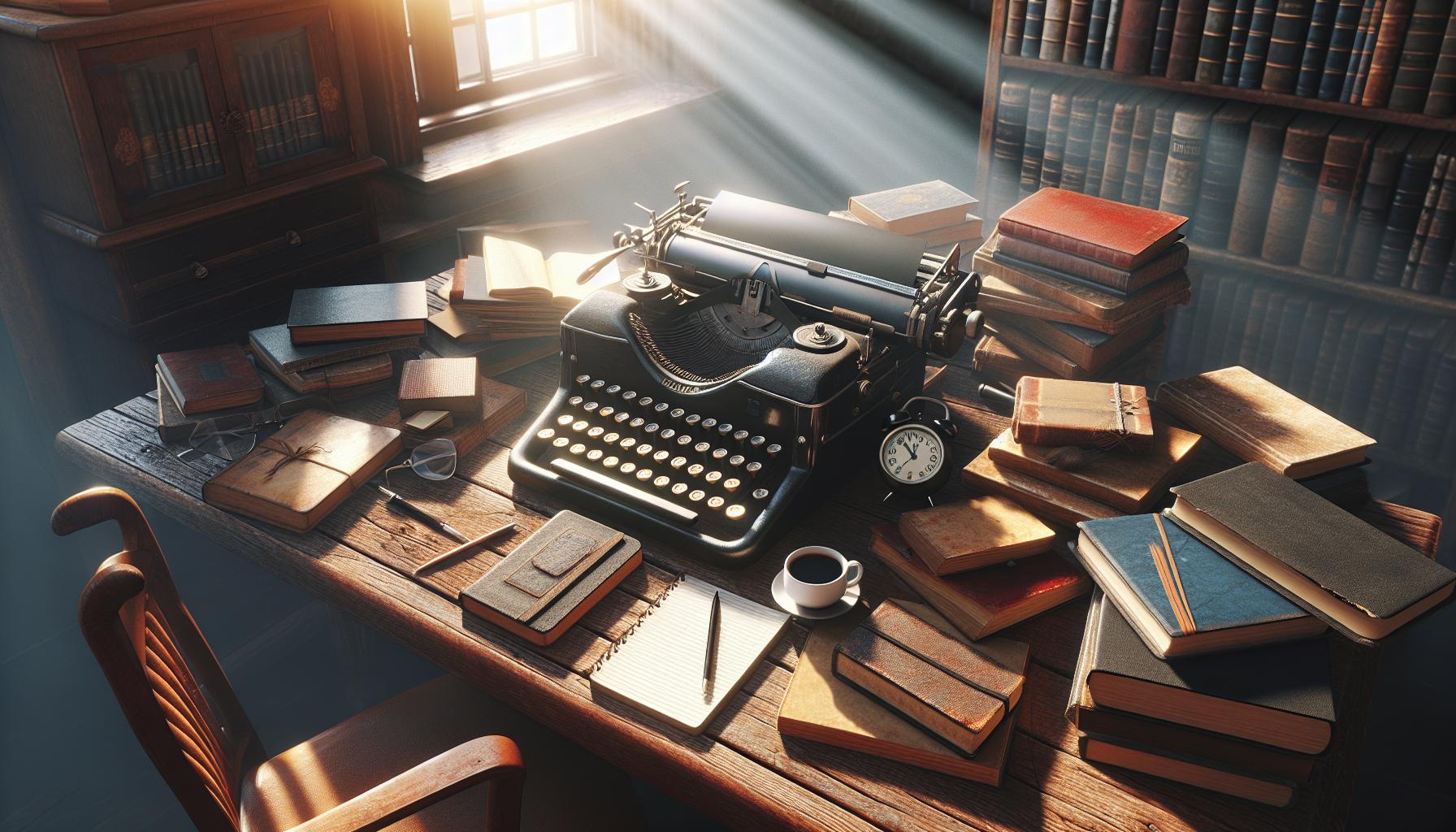Every aspiring writer knows the struggle of staring at a blank page waiting for inspiration to strike. But what if the secret to unlocking creativity lies within the pages of other books? The journey to becoming a better writer doesn’t have to be a lonely road paved with coffee stains and crumpled drafts.
From plot development to character creation these game-changing books on creative writing have transformed countless amateur writers into published authors. They’re packed with practical exercises proven techniques and wisdom from literary giants who’ve mastered the craft. Whether someone’s dreaming of penning the next bestselling novel or simply wants to enhance their storytelling skills there’s a perfect guide waiting to spark their imagination.
Understanding the Essentials of Creative Writing Books
Creative writing books divide into distinct categories that serve different purposes in a writer’s journey. These resources range from theoretical frameworks to practical applications, each offering unique perspectives on the writing craft.
Craft Books vs. Writing Guides
Craft books focus on the technical elements of storytelling through detailed examinations of plot structure, character development, dialogue mechanics. These texts include writing examples, scene breakdowns, literary analysis of successful works. Writing guides emphasize the creative process with exercises, prompts, motivation techniques to help writers establish productive habits. Craft books like “The Art of Fiction” by John Gardner delve into narrative theory while guides such as “Bird by Bird” by Anne Lamott provide strategic approaches to overcome writer’s block.
How to Choose the Right Book for Your Needs
Experience level determines the most beneficial creative writing book for individual writers. Beginning writers benefit from foundational texts that cover basic storytelling principles like “On Writing Well” by William Zinsser. Intermediate writers gain more value from specialized books focusing on specific elements such as dialogue or world-building. Genre-specific guides offer targeted advice for mystery, romance, or fantasy writers. Reading the book’s introduction, table of contents, reviews from other writers gives clear insights into its teaching approach.
| Writer Level | Recommended Book Type | Key Benefits |
|---|---|---|
| Beginner | Basic guides | Core principles |
| Intermediate | Specialized texts | Specific skills |
| Advanced | Genre-specific | Targeted techniques |
Classic Books Every Creative Writer Should Own

The foundation of creative writing mastery lies in studying the timeless works of accomplished authors. These essential books combine practical advice with personal insights that illuminate the craft of writing.
On Writing by Stephen King
Stephen King’s memoir-meets-masterclass delivers practical writing advice through personal experience. The book splits into two distinct sections: King’s journey as a writer and his direct instructions for aspiring authors. He shares specific techniques for character development, dialogue creation and plot construction. King emphasizes writing 1,000 words daily, reading extensively across genres and eliminating unnecessary adverbs. His straightforward rules include avoiding passive voice, cutting 10% of first draft word count and writing primarily for yourself rather than the market. The book provides actionable strategies for establishing a consistent writing routine and maintaining creative momentum through challenging periods.
Bird by Bird by Anne Lamott
Anne Lamott’s approach to writing instruction focuses on breaking overwhelming projects into manageable tasks. She introduces the concept of “short assignments” – focusing on small scenes or descriptions instead of entire manuscripts. Lamott addresses common writer challenges like perfectionism, self-doubt and writer’s block with practical solutions. The book includes specific exercises for developing characters, creating dialogue and crafting effective descriptions. Her guidance on writing “shitty first drafts” liberates writers from self-imposed pressure. Lamott’s methods emphasize observation skills, authenticity in storytelling and maintaining a regular writing practice regardless of inspiration levels.
Books for Developing Story Structure and Plot
Story structure forms the foundation of compelling narratives, transforming ideas into engaging tales that captivate readers. These books provide systematic approaches to crafting well-structured stories with purposeful plots.
Save the Cat! Writes a Novel by Jessica Brody
Save the Cat! Writes a Novel adapts Blake Snyder’s screenwriting methodology for novelists. The book breaks down successful novels into 15 essential plot points called “beats,” creating a universal storytelling framework. Brody examines popular books across genres, demonstrating how each beat functions in different narrative structures. The system includes specific timing guides for plot points, character arc development templates, and scene-building techniques. Authors learn to identify story problems early, create compelling character transformations, and maintain consistent pacing throughout their manuscripts.
Story Genius by Lisa Cron
Story Genius introduces a cognitive approach to story development based on brain science research. Cron reveals how readers’ minds process stories through neural pathways, emphasizing the importance of character-driven plots. The book presents a step-by-step blueprint for creating compelling narratives by focusing on protagonist psychology. Authors discover techniques for developing character misbeliefs, creating internal conflicts, and weaving external plot points that drive meaningful change. The method includes practical tools like scene cards, character questionnaires, and cause-effect relationships that connect plot elements. Cron’s approach helps writers craft stories that resonate with readers on both emotional and intellectual levels.
Books on Writing Style and Voice
Writing style and voice distinguish great authors from good ones. The following books provide essential guidance on developing a distinctive writing style and authentic voice.
The Elements of Style by Strunk and White
“The Elements of Style” serves as a foundational guide to clear, precise writing. This concise manual contains 85 writing principles covering grammar, composition and form. The book outlines specific rules for word usage, sentence structure and paragraph organization through examples. Notable sections include guidance on eliminating unnecessary words, using active voice and maintaining parallel construction. The fourth edition features updates by E.B. White that incorporate modern writing contexts while preserving Strunk’s core principles.
| Key Features | Details |
|---|---|
| Length | 105 pages |
| First Published | 1918 |
| Key Sections | 5 |
| Writing Rules | 85 |
Writing Down the Bones by Natalie Goldberg
“Writing Down the Bones” combines Zen meditation principles with writing practice to develop authentic voice. Goldberg introduces the concept of “writing practice” – timed, continuous writing sessions that bypass internal criticism. The book contains 64 short chapters focusing on specific aspects of the writing process, from dealing with self-doubt to finding inspiration in everyday moments. Each chapter includes practical exercises that help writers access their raw creativity and develop their unique style.
| Key Components | Count |
|---|---|
| Chapters | 64 |
| Writing Exercises | 45+ |
| Practice Methods | 12 |
| Meditation Techniques | 8 |
Genre-Specific Creative Writing Books
Genre-focused writing guides provide specialized techniques tailored to specific literary forms. These resources offer targeted strategies for mastering particular writing styles while addressing unique challenges within each genre.
Writing Fiction: A Guide by Janet Burroway
Janet Burroway’s comprehensive guide stands as the most widely used creative writing text in America. The book breaks down essential fiction elements through contemporary examples from diverse authors. Its chapters cover character development, point of view, narrative structure, setting, revision techniques plus detailed exercises for each concept. Burroway includes annotated passages from published works to demonstrate effective storytelling methods. The guide features practical tools like character questionnaires, plot outlines, scene templates plus strategies for managing multiple storylines.
The Art of Poetry by Kenneth Koch
Kenneth Koch’s guide transforms poetry writing into an accessible craft for writers at any skill level. The text explores fundamental poetic elements including rhythm, meter, imagery plus sound devices through hands-on exercises. Koch presents concrete methods for generating ideas, structuring verses plus refining language choices. His approach incorporates examples from classic poets alongside contemporary works to illustrate various poetic forms. The book contains writing prompts, revision strategies plus techniques for finding inspiration in everyday observations. Writers learn to craft sonnets, free verse, haiku plus experimental forms while developing their unique poetic voice.
Books About the Creative Process
Understanding the creative process enhances a writer’s ability to tap into inspiration consistently. These books explore the psychological aspects of creativity while providing practical methods for sustaining creative momentum.
Big Magic by Elizabeth Gilbert
Big Magic delves into the mysteries of inspiration through Gilbert’s unique perspective on creativity. The book presents six key sections: Courage, Enchantment, Permission, Persistence, Trust and Divinity. Gilbert explores creativity as a relationship between the artist and inspiration, treating ideas as living entities seeking human collaborators. She demonstrates how fear limits creative potential and offers specific strategies to overcome creative blocks. The book includes practical exercises for developing a fearless approach to writing, such as writing letters to fear and creating permission slips for creative endeavors.
The Artist’s Way
The Artist’s Way introduces a transformative 12-week program designed to unlock creative potential. Cameron’s method centers on two core tools: Morning Pages and Artist Dates. Morning Pages involve writing three pages of stream-of-consciousness content each morning to clear mental clutter. Artist Dates require weekly solo excursions to stimulate creative inspiration. The book provides specific exercises for identifying creative blocks, including the Creativity Contract and Creative Affirmations. Cameron emphasizes the importance of establishing rituals that protect creative time and energy while offering strategies for handling creative recovery.
Conclusion
These creative writing books serve as invaluable tools for writers at every stage of their journey. From mastering the fundamentals of storytelling to developing a unique voice each resource offers specific guidance to enhance the writing craft.
Whether it’s through Stephen King’s practical wisdom Elizabeth Gilbert’s creative philosophy or Janet Burroway’s technical expertise these books provide the foundation needed to grow as a writer. They’re not just guides – they’re mentors that help transform creative aspirations into tangible results.
The path to becoming a better writer starts with learning from those who’ve mastered the craft. By incorporating these books into their writing practice aspiring authors can develop the skills confidence and inspiration needed to bring their stories to life.
